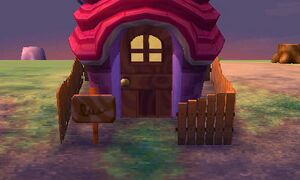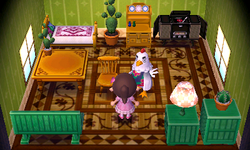Difference between revisions of "Villager house"
HylianAngel (talk | contribs) m (Fixed fossil hobby name.) |
m |
||
| Line 1,098: | Line 1,098: | ||
===In {{NH|short|nolink}}=== | ===In {{NH|short|nolink}}=== | ||
| − | In {{NH}}, each villager has a unique house exterior, although many of these look quite similar. After completing the 30th house and attending DJ KK's concert for the first time in the {{HHP|short}} DLC, the player change a villager's exterior furnishings, including their roof, exterior, door, and any door decorations. | + | In {{NH}}, each villager has a unique house exterior, although many of these look quite similar. After completing the 30th house and attending DJ KK's concert for the first time in the {{HHP|short}} DLC, the player can change a villager's exterior furnishings, including their roof, exterior, door, and any door decorations. |
===In {{HHD|short|nolink}}=== | ===In {{HHD|short|nolink}}=== | ||
Revision as of 21:35, January 15, 2022

In the Animal Crossing series, in addition to player houses, villagers each also possess their own house. They usually move onto signposts around town, except in Animal Crossing: New Leaf, where they can move in anywhere where there is sufficient space, and Animal Crossing: New Horizons, where they move into plots placed manually by the player. Each house differs in appearance slightly and is furnished differently. When a villager moves out, their house will vanish from town, leaving behind a signpost and/or a patch of bare ground.
Houses owned by villagers are always 6x6 in size, and, in games past Animal Crossing, usually cannot be entered by the player unless the villager is inside, with a few exceptions, such as Toy Day in Animal Crossing: City Folk (where Jingle can be inside an empty villager's home).
Designing villager houses is the main element of Animal Crossing: Happy Home Designer and Animal Crossing: New Horizons – Happy Home Paradise, although facilities such as a school can be designed as well.
In New Horizons, the two villagers that move to the deserted island with the player at the start of the game will each initially live in a tent. The player can either recommend the villager to place the tent where they are thinking of putting it, or they can freely choose where these tents are placed via a kit that the villager gives them. The villagers will reward the player for helping them, regardless of which option they choose. Once certain conditions are met, these two villagers will upgrade their tents into houses, having presumably paid their initial getaway package fee much like the player.
Functions
Players can interact with some objects in villager houses, such as musical instruments. If the player opens a storage unit, a message will be displayed, usually about how cluttered the villager's drawers are.
Birthday parties and Flea Markets take place in villager houses, and in the former instance another villager will be present. In Animal Crossing: New Leaf, another animal can sometimes be present even not on the villager's birthday.
In Animal Crossing: City Folk, an animal may lose the key to their house. The player can find it by fishing in the river, and return it to the villager for a reward. The villager will never be permanently locked out, though, even if the player does not help.
Villagers sometimes invite the player over to their house, and the appointment time (chosen by the player) must be at least 30 minutes into the future. The player can sometimes buy an item from the animal.
Exteriors
In Animal Crossing
In Animal Crossing, there are five house exterior models with five colors each. Villagers will always have the same house exterior, and each exterior is shared between several villagers. All islanders share the same house exterior.
In Wild World
In Animal Crossing: Wild World, there are twenty house exterior models with twenty-five colors each. Villagers will always have the same house exterior model, and each exterior model is shared between several villagers. However, the color will vary, which affects the overall texturing of the house, including the color of the door, the color and shape of the windows, and the coloring of the roof. The color associated with each house exterior model is determined when the town is created.
The twenty house exterior models can be categorized into five separate families of four children (A, B, C, and D). The children in each family look nearly identical but have small differences, such as the addition of a chimney, or the addition of a window on the roof. When a town is created, the game randomly associates group A, B, C, and D each with its own unique color from the twenty-five potential colors. For one random example, group A could be assigned color #2, group B could be assigned color #18, group C could be assigned color #12, and group D could be assigned color #23. Therefore, a town will only ever have four different color variants for houses.
In City Folk
In Animal Crossing: City Folk, there are five different styles for houses: classic, pink, ranch, rustic, and stone (non-official names). Towns will only showcase one specific combo of two different styles: classic and pink, classic and stone, pink and ranch, ranch and rustic, or rustic and stone. There are five house exterior models, and each house model has fifteen variations (five different styles with three different colors each). Villagers are associated with five specific house exteriors, one from each house style, and these pools of exteriors are shared between several villagers.
| 100px |

|

|
In New Leaf

In Animal Crossing: New Leaf, each villager has a unique house exterior, although many of these look quite similar. Each house has a chimney that releases uniquely-shaped smoke plumes, which can be either oval, butterfly, fish, flower, or star-shaped. Oval-shaped is the most predominant type.
In New Horizons
In Animal Crossing: New Horizons, each villager has a unique house exterior, although many of these look quite similar. After completing the 30th house and attending DJ KK's concert for the first time in the Happy Home Paradise DLC, the player can change a villager's exterior furnishings, including their roof, exterior, door, and any door decorations.
In Happy Home Designer
In Animal Crossing: Happy Home Designer, the player may customize the exterior of each villager's home and its surrounding area. Like in Animal Crossing: New Leaf, each house has a chimney that releases uniquely-shaped smoke plumes. The shape is identical to their New Leaf counterparts.
Interiors

Villager houses are always 6x6 in size and, with the exception of the two starting villagers' tents upgrading to houses in Animal Crossing: New Horizons, never expand, unlike the player's home. Each villager starts with different furniture, but this changes over time, such as when the player mails them new items or when the villager (or a player) buys items at the Flea Market. For Animal Crossing: Wild World and Animal Crossing: City Folk, wallpaper and flooring may change if the player sends a letter to a villager with one of these attached as a gift. In Animal Crossing: New Leaf and Animal Crossing: New Horizons, they will always retain their wallpaper and flooring, so gifting them new wallpaper and flooring will have no effect.
In Animal Crossing and Doubutsu no Mori e+
In Animal Crossing, villager houses feature a fixed furniture layout that cannot be changed. In Doubutsu no Mori e+, villagers who are new to the game feature identical furniture layouts to specific existing villagers, albeit with different wallpaper, flooring, and songs. Unlike in later games, villager houses can be entered by the player if the villager is not home.
In Wild World and City Folk
Furniture layouts in villager homes are mostly the same between Animal Crossing: Wild World and Animal Crossing: City Folk, though there are some exceptions.
- A piece of furniture may be rotated. For example, the Water Bird in Nibbles's house is rotated 90 degrees between Wild World and City Folk.
- A piece of furniture may be substituted. For example, Elvis's house features two Thrones in Wild World that are replaced with Regal Chairs in City Folk.
- A piece of furniture may swap positions with another piece of furniture. For example, the Office Locker and Tape Deck in Camofrog's house swapped positions between Wild World and City Folk, making the Tape Deck easier to see in City Folk.
- If a villager has the "digging up fossils" hobby, the furniture in their house will have an altered arrangement with empty space in one of the four corners to accommodate a large fossil.
Additionally, villagers may occasionally change the location of furniture in their house and randomly throw away furniture each day after moving in.
In New Horizons
In New Horizons, the first five villagers' houses have default interiors with basic furniture, flooring, and wallpaper, tailored to their base personalities (as there will always be one each of jock, big sister, normal, peppy, and lazy)—whereas all subsequent villagers have furnishing customized to their individual characters as in past games. Nonetheless, there is still some variation in the exact items each villager starts with, based in part on character and the island's native fruit and flowers. The house exteriors are consistent with what those same characters would have gotten if they moved in later. Prior to the release of Happy Home Paradise these villagers were not able to "upgrade" to their default furnishings while on the same island, though if they are adopted by another island they will reset to their standard furnishings, and retain them if they then move back.
With the release of Animal Crossing: New Horizons – Happy Home Paradise, after completing the 30th house on the archipelago and attending DJ KK's first concert on the main archipelago island, the houses of the villagers on the player's island can be customized via Tom Nook, including the ability to reset to that villager's default furnishings, even for those in the first five. The player can also utilize lighting, soundscapes, and polishing when remodeling a house, though room-size adjustments will be unavailable for the remodeling of a villager's house. The player can also ask Isabelle to reset the villager's interior to their default furnishings, though this requires the ability for villager house customization on the player's island.
Initial houses in New Horizons:
- The jock starter villager's house will have craftable items primarily from the Wooden set, but not all items from that set, with some varying randomly (e.g., he may or may not have a bed or wardrobe). The villager may also initially retain the Lantern, Portable Radio, and Sleeping Bag from his tent. Item colors may also vary depending on the character.
- Furnishings for big sister starter villagers are the same, except for most items being from the Wooden Block Series.
- Normal, peppy, and lazy starter villagers will have a combination of non-craftable furniture (consistent for each personality), plus items crafted by players during the island development storyline, primarily from the Wooden (normal), Wooden Block (peppy), and Log and applicable native fruit sets (lazy).
See also
- List of villager houses in Animal Crossing
- List of villager houses in New Leaf
- List of villager houses in New Horizons



























































































